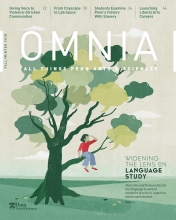An international team led by geneticist Sarah Tishkoff has identified new genetic variants associated with skin pigmentation. While most genes known to contribute to normal variation in skin color have been discovered through studies of European populations, the new study, published in the journal Science, incorporated samples from diverse African groups.
The findings help explain the vast range of skin color on the African continent, shed light on human evolution, and inform an understanding of the genetic risk factors for conditions such as skin cancer.
“We have identified new genetic variants that contribute to the genetic basis of one of the most strikingly variable traits in modern humans,” says Tishkoff, the David and Lyn Silfen University Professor in Genetics and Biology with appointments in the School of Arts and Sciences and the Perelman School of Medicine. “When people think of skin color in Africa most would think of darker skin, but we show that within Africa there is a huge amount of variation, ranging from skin as light as some Asians to the darkest skin on a global level, and everything in between.”
Tishkoff and colleagues measured the light reflectance of the skin—a stand-in for melanin content—of more than 2,000 Africans from ethnically and genetically diverse populations. They found the darkest skin in Nilo-Saharan pastoralist populations in eastern Africa, and the lightest skin in San hunter-gatherer populations in southern Africa.
Using genetic information from nearly 1,600 people, the researchers found four key areas of the genome where variation closely correlated with skin color differences.
The region with the strongest associations was in and around the SLC24A5 gene, one variant of which is known to play a role in light skin color in European and some southern Asian populations and is believed to have arisen more than 30,000 years ago. This variant was common in populations in Ethiopia and Tanzania that were known to have ancestry from Southeast Asia and the Middle East, suggesting it was carried into Africa from those regions.
Another region, which contains the MFSD12 gene, had the second strongest association to skin pigmentation. This gene is expressed at low levels in depigmented skin in individuals with vitiligo, a condition where the skin loses pigment in some areas.
“I still remember the ‘Ah ha!’ moment when we saw this gene was associated with vitiligo,” says Nicholas Crawford, a former Penn postdoctoral fellow who worked in collaboration with Tishkoff. “That’s when we knew we’d found something new and exciting.”
Additional associations with skin color were found in the OCA2 and HERC2 genes, which have been linked with skin, eye, and hair color variation in Europeans, though the mutations identified are novel. And a final genetic region the researchers found to be associated with skin pigmentation included genes that play a role in ultraviolet light response and melanoma risk.
“Africans don’t get melanoma very often,” Tishkoff says. “The variants near these genes are highest in populations who live in areas of the highest ultraviolet light intensity, so it makes sense that they may be playing a role in UV protection.”
The work gives a broader picture of the evolution of skin color in humans. Most of the genetic variants associated with light and dark pigmentation from the study appear to have originated more than 300,000 years ago, and some emerged roughly 1 million years ago, well before modern humans evolved. The older version of these variants in many cases was the one associated with lighter skin, suggesting that perhaps the ancestral state of humans was moderately pigmented rather than darkly pigmented skin.
Tishkoff noted that the work underscores the diversity of African populations and the lack of support for biological notions of race.
“We show that skin color is extremely variable on the African continent and that it is still evolving,” Tishkoff says. “There’s no such thing as an African race.”
The study was conducted with support primarily from the National Institutes of Health and the National Science Foundation.





